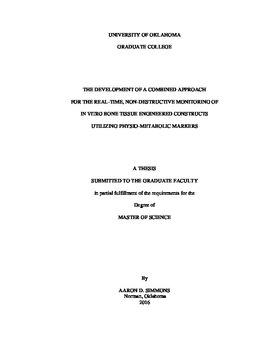| dc.description.abstract | Annually, over $2.5 billion is spent on more than 500,000 bone grafts in the US alone, with more than 2 million being implanted worldwide. The limited supply of autografts and complications associated with traditional alternatives leave much to be desired. As of late, bone tissue engineering has developed as a promising alternative to these “gold standard” strategies for bone regeneration, effectively combining a patient’s own cells with biological factors together on a supportive construct to promote and induce de novo bone tissue formation. Due to the complexity involved in such an approach, its pathway to clinical application is wrought with numerous regulatory demands, all of which must be met in order to secure FDA approval prior to realization of clinical relevance. Key among these is the ability to monitor tissue engineered constructs, being able to effectively track such key aspects of construct quality as cellularity and degree of maturation (differentiation and mineralization). In the field, current methodologies for the determination of said aspects require the sacrificial destruction of the cultured constructs, an obviously infeasible practice for regenerative medical applications. As such, the main objective of this study was the development of alternative strategies for the real-time, non-destructive monitoring of bone tissue engineered constructs.
To this end, constructs comprised of 85% porous poly(L-lactic acid) (PLLA) spunbonded fibrous scaffolds were dynamically seeded with 1.5 MM rat mesenchymal stem cells (rMSCs) and cultured within flow perfusion bioreactors (providing for the mitigation of nutrient gradients and the beneficial introduction of shear stresses throughout the construct) with either basal or osteoinductive media for periods of up to 14 days. Throughout the culture period, oxygen concentration measurements were taken at the inlet and outlet of each construct and global media samples were taken and assayed for glucose and osteoprotegerin content in order to determine oxygen uptake, glucose consumption, and osteoprotegerin (OPG) production rates. As specified time points throughout the culture period (Days 1, 3, 5, 7, 9, 11, and 14), constructs were sacrificed and assayed for cellularity (via a dsDNA assay), alkaline phosphatase (ALP) activity, and calcium deposition. Comparative analysis of trends in both the non-invasive mid-culture and destructive post-culture data revealed correlations that can be utilized for the real-time, mid-culture determination of construct quality. Key trends observed include increases in the cell-specific rate of oxygen uptake and decreases in the cell-specific rate of glucose consumption by osteoinduced constructs with little change in non-osteoinduced ones and a steady cell-specific production rate of OPG for osteoinduced cultures as compared to significantly decreased production rates for non-osteoinduced cultures. The opposing trends for oxygen uptake and glucose consumption of osteoinduced cultures can be explained my metabolic shifts in differentiating MSCs, a phenomenon which has proven useful in the development of monitoring metrics herein. Utilization of the ratio of oxygen uptake rate to glucose consumption rate as a key determinant of construct quality has proven promising in the analyses performed herein, potentially allowing for the elucidation of both a construct’s maturation and its cellularity non-destructively in real time. | en_US |
